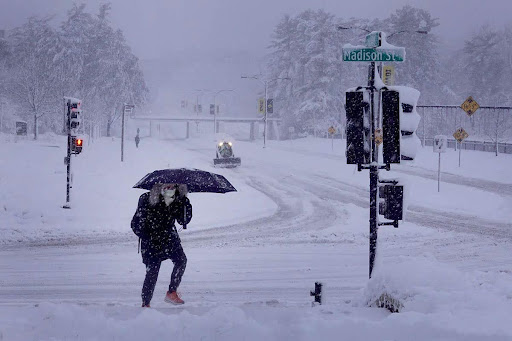Winter Storm Finn, a complex meteorological phenomenon that unfolded in January 2024, stands as a testament to the raw power and unpredictable nature of severe weather events. From its unorthodox southward trajectory to its multifaceted impacts across diverse regions, Finn’s journey etched a remarkable path through the American landscape, leaving behind a tapestry of disruption, resilience, and valuable lessons learned.
A Rogue Storm Charts Its Course
 Image Source: The Weather Channel
Image Source: The Weather Channel
Unlike its typical eastward-bound counterparts, Finn emerged from the frigid embrace of the Gulf of Alaska on January 5th, defying established storm patterns. Instead of traversing across Canada, it embarked on a southwestward voyage, plunging Washington and Oregon into a wintry abyss with substantial snowfall. By January 6th, Lake Tahoe received the brunt of its fury, witnessing whiteout conditions and perilous mountain travel.
Ballooning Blizzards in the Heartland
On January 7th, Finn reached the Great Plains, its icy tendrils wrapping around Nebraska, Wyoming, and Kansas. Blizzard warnings became a constant refrain, with wind gusts exceeding 70 mph whipping snowfall into blinding curtains. Interstate 80 transformed into a white ghost, rendering travel near impossible. Schools closed their doors, emergency responders became beacons of hope amidst the swirling chaos, and state emergencies were declared, underscoring the storm’s severity.
Beyond the Whiteout: A Spectrum of Threats
 Image Source: The Weather Channel
Image Source: The Weather Channel
As Finn weakened on January 8th, its character shifted. Instead of remaining a winter warrior, it morphed into a multifaceted menace. Damaging winds pirouetted across the South, spawning tornadoes in Alabama and Georgia that ripped through communities, leaving a trail of destruction and claiming tragic lives. Meanwhile, the Mid-Atlantic and Northeast braced for a different kind of assault – a steady, relentless downpour that drenched the region, exacerbating existing flood concerns from previous storms.
Aftermath: From Rebuilding to Reflection
By January 9th, Finn finally relinquished its grip. In its wake lay a patchwork of challenges. Millions remained in the dark, the economic pulse throbbed with the pain of lost productivity and billions in damages, and travel arteries remained choked with snowdrifts. Yet, amidst the disruption, flickered the indomitable spirit of communities. Neighbors helped neighbors, first responders tirelessly cleared paths, and volunteer initiatives bloomed. It was a testament to the human capacity for resilience in the face of adversity.
Lessons Learned: From Preparedness to Cooperation
 Image Source: Weather Underground
Image Source: Weather Underground
Winter Storm Finn wasn’t just a collection of data points – snowfall totals, wind speeds, and economic losses. It was a human drama played out on a national stage, highlighting the importance of preparedness and proactive planning. The storm’s unusual track reminded us that established patterns can be rewritten, demanding adaptable response strategies. It also reinforced the crucial role of inter-agency collaboration and effective communication during emergency situations.
A Story Beyond the Headlines
Finn’s journey wasn’t merely a meteorological blip on the radar. It was a story of truck drivers battling whiteout conditions, families huddled around flickering candlelight, and utility crews braving icy winds to restore power. It was a reminder of the interconnectedness of our communities and the vulnerability we share in the face of nature’s unpredictable wrath.
A Continuing Legacy
As we navigate a changing climate with increasingly volatile weather patterns, Winter Storm Finn’s legacy resonates deeply. It serves as a cautionary tale, urging us to prioritize preparedness, cultivate resilience, and foster robust community collaboration. By acknowledging the lessons etched in the snowdrifts and power outages, we can better equip ourselves to face the storms, both literal and metaphorical, that may lie ahead.
Additional Details
- Beyond the blizzards, Finn brought record-breaking cold to parts of the country, with temperatures plunging below -20°F in Minnesota and Iowa.
- The National Guard was deployed in several states to assist with storm response and recovery efforts.
- The agricultural sector suffered significant losses due to widespread crop damage caused by the blizzard conditions.
- The aftermath of the storm saw an upsurge in community donations and volunteer initiatives, illustrating the spirit of solidarity and support across the nation.
Key Takeaways
Winter Storm Finn Classification and Characterization:
- Extratropical Cyclone: At its core, Finn was an extratropical cyclone, a storm driven by temperature differences between warm and cold air masses. Unlike tropical cyclones (hurricanes) that derive energy from warm ocean waters, extratropical cyclones form over land or cold ocean surfaces.
- Blizzard: In the Great Plains and Midwest, Finn transitioned into a blizzard, characterized by sustained winds exceeding 35 mph, visibility below a quarter mile for at least three hours, and significant snowfall.
- Severe Thunderstorm System: As Finn weakened on January 8th, it transitioned into a severe thunderstorm system, spawning tornadoes across the South.
- Rainstorm: The Mid-Atlantic and Northeast experienced Finn’s impact as a heavy rainstorm, exacerbating existing flood concerns.
Understanding the Terminology
These classifications emphasize Finn’s multifaceted nature. While blizzard conditions dominated headlines in the Plains and Midwest, other regions experienced different elements of the storm’s wrath. These distinctions highlight the varied impacts and response needs across the affected areas.
Conclusion
Winter Storm Finn stands as a significant meteorological event, etching a path of disruption across the American landscape in January 2024. Its unconventional trajectory and multifaceted impacts offer valuable lessons regarding the necessity of preparedness and adaptability in the face of extreme weather events.
While the economic ramifications and physical damage were substantial, the storm also highlighted the human capacity for resilience and the importance of community collaboration in navigating such challenges.
Looking forward, Winter Storm Finn’s legacy prompts us to prioritize proactive measures in disaster response and planning. Embracing robust communication channels, fostering inter-agency cooperation, and cultivating community preparedness through awareness campaigns are crucial steps in mitigating the impact of future storms.
By acknowledging the vulnerabilities Finn exposes and actively preparing for similar disruptions, we can build stronger communities and navigate the uncertainties of a changing climate with greater confidence and collective strength.



Leave a Reply